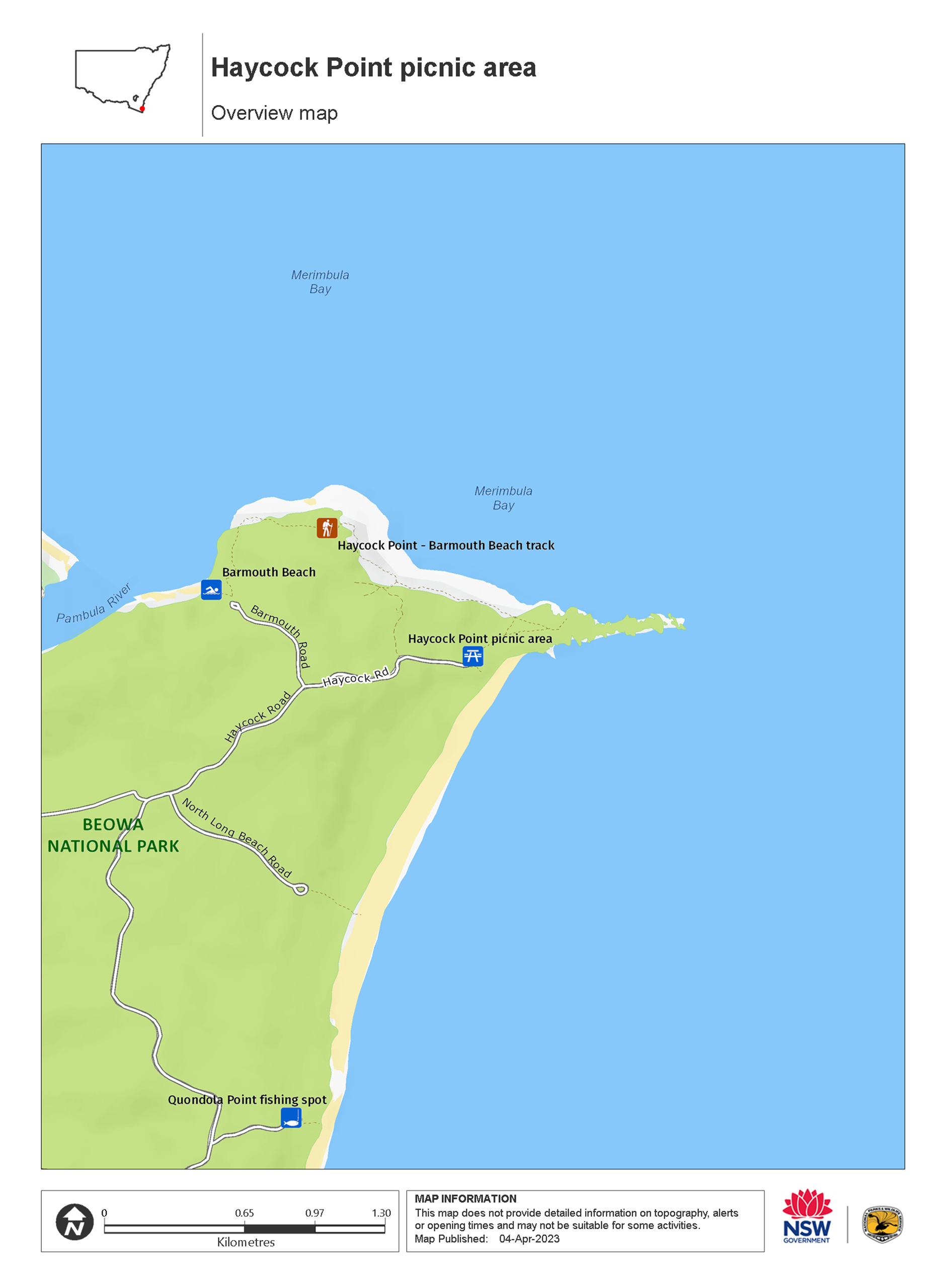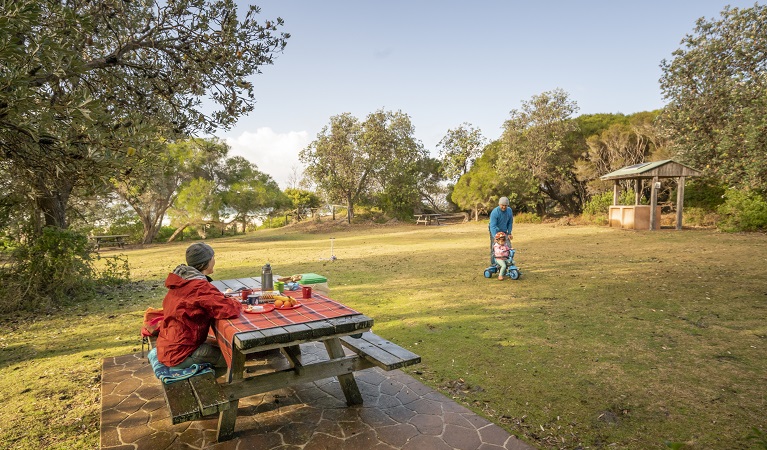Overview
Haycock Point picnic area is a great place for lunch with family and friends in the Pambula area of Beowa National Park. Enjoy coastal views, winter whale watching, and easy access to scenic walks.
- Type
- Picnic areas
- Where
- Pambula-Haycock area in Beowa National Park in South Coast
- Accessibility
- Medium
- What to
bring - Hat, sunscreen, snacks, drinking water, cooking water
- Please note
- Remember to bring your binoculars if you want to birdwatch or spot whales.
Located a short drive from Pambula or Eden on the NSW Sapphire Coast, Haycock Point picnic area is a favourite with families, tourists and locals. Relax at a shaded picnic table while the kids play on the grass, and enjoy the wonderful ocean views as you eat.
When you've finished lunch, there’s lots on offer, from fishing and swimming to birdwatching or bushwalking. For a short walk, the 10min Haycock Point walking track takes you to the spectacular point. If you’re feeling energetic, the 3km Haycock Point to Barmouth Beach walking track starts from the picnic area and is great for all ages.
Beautiful but unpatrolled, Long Beach stretches south from Haycock Point and is a popular spot to surf and fish. You can also drive to the nearby Pinnacles formation, or visit Severs Beach to see Aboriginal middens.
The weather and water are warmest from summer through to Easter, but this is a beautiful spot at any time of year. Visit on a clear, sunny winter day to catch a glimpse of a whale breaching out deep, while sea birds soar over the coastline. You might see echidnas, goannas, or kangaroos and wallabies grazing as you cook your barbecue.
Also see
-

Quondola Point
Quondola Point is a rocky outcrop overlooking Long Beach, between Pambula and Eden. It’s a great spot to fish for salmon, tailor and bream. Combine it with a visit to the nearby Haycock Point picnic area.
Map

Map legend

Local alerts
For the latest updates on fires, closures and other alerts in this area, see https://www.nationalparks.nsw.gov.au/things-to-do/picnic-areas/haycock-point-picnic-area/local-alerts
General enquiries
- National Parks Contact Centre
- 7am to 7pm daily
- 1300 072 757 (13000 PARKS) for the cost of a local call within Australia excluding mobiles
- parks.info@environment.nsw.gov.au
Park info
- in the Pambula-Haycock area of Beowa National Park in the South Coast region
The Pambula-Haycock area of Beowa National Park is always open but may have to close at times due to poor weather or fire danger.
Visitor info
All the practical information you need to know about the Haycock Point picnic area.
Getting there and parking
Haycock Point is in the northern area of Beowa National Park, between Pambula and Eden. To get there:
From Pambula:
- Drive south on Princes Highway for around 9km.
- Turn left at Haycock Road to enter Beowa National Park.
- Follow the road 6km to its end, where you’ll reach Haycock Point picnic area.
From Eden:
- Drive north along Princes Highway for 6km.
- Turn right at Haycock Road to enter Beowa National Park.
- Follow the road 6km to its end, where you’ll reach Haycock Point picnic area.
Road quality
- Unsealed roads
Vehicle access
- 2WD vehicles
Weather restrictions
- All weather
Parking
Parking is available in roadbase carparks at the picnic area.
Facilities
There’s no drinking water at this picnic area, so you’ll need to bring your own supply for drinking and cooking.
Toilets
- Non-flush toilets
Picnic tables
Barbecue facilities
- Gas/electric barbecues (free)
- Wood barbecues (bring your own firewood)
Carpark
Step-free access
The picnic area is flat and step-free with a hard-packed ground path that leads to the toilets. You'll need to cross over flat grass to reach the rest of the facilities.
The access path that leads to the beach has steps.
- Step-free outdoor pathways
Maps and downloads
Accessibility
Disability access level - medium
- Haycock Point picnic area is flat and step-free with an accessible toilet that's set at the end of a hard-packed ground path.
- You'll need to cross over flat grass to reach the rest of the facilities.
- There are steps along the trail that leads to the beach.
Permitted
Camp fires and solid fuel burners
Wood fires are permitted only in the designated wood barbecues. Please bring your own firewood. You can bring your own solid fuel and liquid stoves or use the gas barbecue facilities provided.
Fishing
A current NSW recreational fishing licence is required when fishing in all waters.
Prohibited
Chainsaws aren't permitted in Beowa National Park.
Camping
Gathering firewood
Generators
Horses
Horse riding is only permitted on the public access road system, and not elsewhere in the park.
Pets
Pets and domestic animals (other than certified assistance animals) are not permitted. Find out which regional parks allow dog walking and see the pets in parks policy for more information.
Smoking
NSW national parks are no smoking areas.
Learn more
Haycock Point picnic area is in Pambula-Haycock area. Here are just some of the reasons why this park is special:
Aboriginal culture

The Yuin People are the Traditional Owners and Custodians of Beowa National Park and they have a long and complex relationship with the coastal environment. Some of the best preserved mounded middens on the east coast of Australia are found in the park along the Pambula River. These middens contain the shells of oysters, mussels and sometimes the bones of sea and land mammals—collected by Aboriginal people from the rock platforms, reefs and estuaries along the park’s coastline.
- Guided Aboriginal cultural tour in Eden Discover the rich culture of the Thaua People on an immersive cultural tour with Eden Local Aboriginal Land Council. You’ll see stunning coastal landscapes in and around Beowa National Park.
- Severs Beach Severs Beach, in Beowa National Park in the whale watching town of Eden on NSW’s Sapphire Coast, offers Aboriginal heritage, fishing, beach walks and more.
Rocks tell a story

The park’s stunning rock formations, inlets and headlands are the result of extensive geological folding. Most of Beowa National Park lies on red, brown and green shales, sandstones, siltstones and quartzites. These were formed in the Devonian period around 360 million years ago, before dinosaurs roamed the earth. You can see these rock types exposed along the cliffs and headlands. The Devonian period is known as The Age of Fishes and internationally-significant fish fossils have been found in several places along the park’s coastline.
- Haycock Point to Barmouth Beach walking track The walk from Haycock Point to Barmouth Beach in Beowa National Park takes in whale watching, scenic coastal views, wildlife and birdwatching opportunities.
- Pambula River kayaking tour Experience Beowa National Park from the crystal-clear waters of the Pambula River on this exciting guided kayaking tour with Navigate Expeditions.
Refuge for threatened species

Several threatened species take refuge in the Pambula-Haycock area. North of Pambula River there's an important population of yellow-bellied gliders—listen carefully for their trademark crackles and shrieks. Around 50 native mammals and nearly 150 species of birds have been recorded in Beowa National Park. This includes 1 critically endangered bird, 4 endangered animal species and 25 vulnerable species.
- Haycock Point to Barmouth Beach walking track The walk from Haycock Point to Barmouth Beach in Beowa National Park takes in whale watching, scenic coastal views, wildlife and birdwatching opportunities.
- Pambula River kayaking tour Experience Beowa National Park from the crystal-clear waters of the Pambula River on this exciting guided kayaking tour with Navigate Expeditions.
Plants and animals protected in this park
Animals
-

Australian pelican (Pelecanus conspicillatus)
The curious pelican is Australia’s largest flying bird and has the longest bill of any bird in the world. These Australian birds are found throughout Australian waterways and the pelican uses its throat pouch to trawl for fish. Pelicans breed all year round, congregating in large colonies on secluded beaches and islands.
-

Australian fur seal (Arctocephalus pusillus doriferus)
The largest fur seal, Australian fur seals are found in isolated rocky outcrops and islands along the NSW coast. They come ashore to form breeding colonies and can often be seen at Barunguba Montague Island Nature Reserve.

